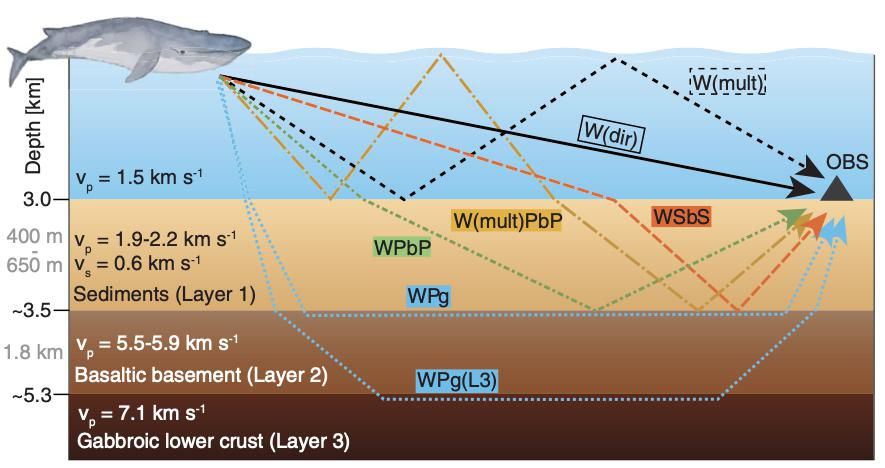
Fin whale songs contain signals that are reflected and refracted within the rock layers beneath the … [+]
Kuna et al. 2021/Science
A study published this week in the journal Science shows how the songs of fin whales (Balaenoptera physalus) can be used for seismic imaging of the oceanic crust.
Fin whale songs contain signals that are reflected and refracted within the oceanic crust, including the sediment and the solid rock layers beneath. These signals, recorded on seismometers on the ocean bottom, can be used to determine the thickness of the layers as well as other information relevant to seismic research, said John Nabelek, a professor in Oregon State University’s College of Earth, Ocean, and Atmospheric Sciences and a co-author of the paper.
“People in the past have used whale calls to track whales and study whale behavior. We thought maybe we can study the Earth using those calls,” Nabelek said. “What we discovered is that whale calls may serve as a complement to traditional passive seismic research methods.”
Seismologists study Earth’s structure by either passively listening to the signals of natural earth movements, like earthquakes, or by actively sending artificial seismic signals, by detonating charges or using heavy hydraulic equipment (called air guns), through the underground.
The study’s lead author Vaclav M. Kuna, who worked on the project as a doctoral student at Oregon State, and Nabelek were studying earthquakes from a network of 54 ocean-bottom seismometers placed along the Blanco transform fault, which at its closest is about 100 miles off Cape Blanco on the Oregon Coast. They noted strong signals on the seismometers that correlated with whales’ presence in the area. “After each whale call, if you look closely at the seismometer data, there is a response from the Earth,” Nabelek said.
A typical whale song consists of a series of clicks or second-long bursts separated by dozens of seconds of silence and can go on for hours. A fin whale’s song can reach 190 decibels. After prolonged exposure to levels above 80 decibels people can start to suffer from permanent hearing loss. Rock concerts on land can be as loud as 120 decibels.
Using a series of whale calls that were recorded by three seismometers, the researchers were able to pinpoint the whale’s location and use the vibrations from the calls to create images of the Earth’s crust layers.
When whale calls bounce between the ocean surface and the ocean bottom, part of the energy from the calls transmits through the ground as a seismic wave. The wave travels through the oceanic crust, where it is reflected and refracted by the ocean sediment, the volcanic basalt layer underneath it and the igneous gabbroic lower crust below that.
“The current traditional method for imaging of the crust can be expensive and permits can be difficult to obtain because the work involves deploying air guns.” The imaging created using the whale songs is less invasive, though overall it is of lower resolution. Seismologists listening to whale songs could be added to conventional surveying. “This expands the use of data that is already being collected,” Nabelek said.
This article is auto-generated by Algorithm Source: www.forbes.com


